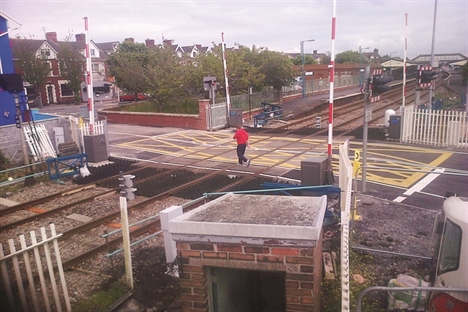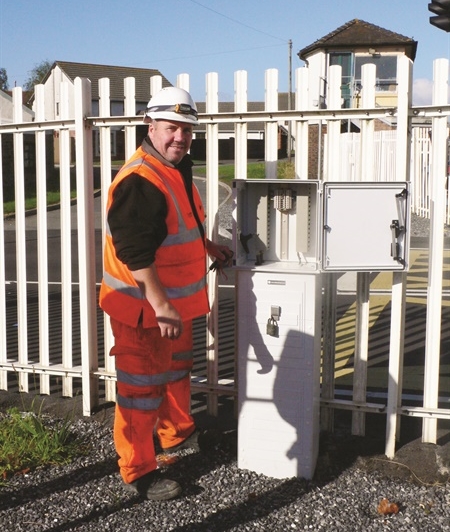31.10.13
Safety first
Source: Rail Technology Magazine Oct/Nov 2013
A level crossing upgrade at Llanelli in south Wales at two crossings either side of the station grew in scope to encompass some first-of-their-kind innovations to improve safety. RTM talked to Amey’s rail project manager Mark Bushnell and signal installation supervisor Thomas John, as well as suppliers Nigel Young from Weidmuller and Mark Challinor from Cablecraft.
The two level crossings at Llanelli, either side of the station – known as ‘East’ and ‘West’ – date back to the 1800s and were last renewed in the 1970s.
Network Rail commissioned Amey to renew the crossings, under a design and construct contract (GRIP stages 4-8), to bring them up to modern standards for MCB– Obstacle Detection (OD).
This system uses a system of obstacle detector sensors – radar and laser scanners to check the crossing is clear and inductive loops to check that the barriers will not lower onto a road vehicle directly beneath a barrier.
The system is designed to minimise the chance of damage to barrier equipment, road vehicles and avoid trapping of a user.

The work included the provision of a new relay room, an upgrade to the existing Llanelli relay room, and re-control of the crossing to Port Talbot Panel Signal Box.
Mark Bushnell, Rail Project Manager for Amey, based at the company’s Radyr depot on the outskirts of Cardiff, told RTM: “The contract was typical – Amey’s probably done in excess of 25-30 level crossings over the last 10-15 years.”
Amey wanted to take the opportunity to come up with new ways of terminating cables using industry standard terminals, which are smaller and good in high vibration environments.
However, signalling systems are designed to be fail safe in the event of a high resistance or open circuit.
Amey also wanted to come up with a better way of isolating the level crossing battery to make maintenance easier and safer.
Bushnell explained that these had been issues for a significant amount of time, telling us: “From a signalling installers’ point of view, it’s been in the back of their mind that this is a problem for the installation of new battery supply and replacement.
“It was about having the time and inclination to investigate a better method of undertaking the installation.
“Tom had the interest, the knowledge and the technical experience to develop a solution. He brought in key suppliers and got their input.”
John explained that while building the new REBs at Radyr, the team took the opportunity to re-evaluate the whole design and come up with something new.
The Amey team held a meeting with key suppliers Weidmuller and Cablecraft to try to identify a new option, as they had the specific expertise to handle the problem.
He explained: “We went for a bolted connection instead of a screw-pressure terminal, which could be torqued up to a specific torque.
“It means you know that when you go back, even if it’s a year later, it’s still going to be tight.We went ahead and installed them. That was the bolted side of it.
“As soon as we started changing part of the rack, we started to look at the rest of the rack and trying to make it all bolted and maybe break it down into different parts so we could isolate the battery.
“We ended up revamping the whole power rack, and the whole battery rack; isolators were put in to get it up to the required standard.
“We also moved to spring-loaded terminals. This means you’ve got the screw connection but also a spring-loaded connection to hold it in.
“Over a period of time we ended up looking at the whole mechanics of the cabling connections with Cablecraft and Weidmuller, and held a number of meetings.”
Bushnell said: “Between us we eventually came up with an acceptable solution to Network Rail.
“The cable suppliers are now trying to package it up – ‘here’s all the part numbers and costs and it’s a one-stop-shop package’ – so there’s no scratching of heads and no-one reinventing the wheel every time they want to order something.”
He added: “The safety aspect was one of the key drivers for what we did inside the REB – isolating the electrical equipment.
“There are two benefits there; firstly, you don’t want anything getting too hot and potentially catching fire.
“Secondly, if anyone has to go in there to do work, there are a series of isolation points that can be individually padlocked and procedures that can be used that mean things can be isolated and worked on safely.
“We feel our solution could be easily replicated and used on all level crossings throughout the country when they are renewed.”
Nigel Young, industry manager for rail infrastructure at Weidmuller, told RTM: “We’ve got reliable products and were happy to get involved in the consultative process.
“We were keen to understand the issues Amey was having and go away and come back with some alternatives to make it work.”
Young continued: “Amey had some concerns with the Port Talbot panel previously regarding termination problems. They asked us if we had suitable products that would provide a solution and enhance safety.
“Safety, from the top to the bottom was the buzzword on the project.”
Explaining more about the specific products chosen, Young said: “The WTLs – the spring-loaded terminals – were mainly used on the links in the REB and also in the Trackside Disconnection Boxes.
“They’re a fully-fledged Network Rail approved product providing increased safety; it’s a screw terminal with the back-up of a helical spring which sits below the clamping-yoke.
“Under shock and vibration, you’ve got the assurance that the spring will hold the hook bladed conductor in place. That’s the increased safety.
“The same argument applies to the bolted terminals for the larger ring crimped cables. We have a toothed-washer system on the terminal and once the correct torque is used to tighten the terminal, it’s ‘fit and forget’.
“This terminal range, whilst going through Network Rail approval at the moment, is already credited with many of the European Rail approvals and RIA 20 for rolling stock.
“The hinged terminal hood ensures the connection is completely touchproof and comes with a handy built in testpoint.”
Mark Challinor, technical sales engineer from Cablecraft, explained: “There was an innovation challenge. I’ve always thought a solution could be found, but it was about finding people prepared to take up those ideas; we were fortunate that Amey were prepared to listen to what mine and Nigel’s solutions were to the problems at Llanelli.
“The ultimate solution was, basically, off-the-shelf: we weren’t over-engineering a solution to suit this particular problem. We were adapting products that are already out there, which are used in similar settings where you’ve got vibration or where safety is an important factor.
“We’ve now got a lockable switch, so the power can be safely isolated. We’ve got bolted connections and better connectivity.
“It’s similar with the battery isolation: we’ve got safety when isolating the supply, they’re lockable and can be maintained at any time.”
Safer disc boxes
The innovations made as part of the level crossing project did not stop inside the REB.
John told us: “Once we’d looked at the REB and, as a working party, with Network Rail’s involvement – we looked at the outside.
“When we started to install the Obstacle Detection, we came across a lot of hypodermic needles on the ground, which was quite a problem. The old disc boxes are close to the ground, which means you have to kneel down.
“We thought we could get them up off the ground to a better working height, and make them plug coupler ready.
“There were lots of boxes on the market but they didn’t fit the bill as being plug coupler ready. The boxes out there weren’t at the height we wanted, they didn’t fit onto a standard base.
“But the guys from Weidmuller and Cablecraft went away and came back with something much better. These are built from reinforced plastic, they’re lightweight and non-reflective, which is important on crossings. They presented it to me, and we took it to Network Rail and everyone seemed to like it, and that’s what we ended up installing down there with Network Rail. “We revamped the whole disc connection box as well. That was a first, as far as I know.”
Mark Challinor from Cablecraft said: “We looked at solutions to power switching, then we moved onto the distribution solutions on the trackside. That’s where we came in. It was a case of looking for products that were fit for purpose but also non-bespoke, products that are proven.
“The ultimate solution is plug coupler-ready, made of a lightweight and robust material with ease-of-access. They’re at an ergonomic angle and a much better working height.
“Working with Tom and Nigel the enclosed system and solution also had a low metal content, which enhanced safety with regards to conductivity and is unattractive to metal thieves.”
Bushnell added: “Working at a safe height is also good in terms of reducing tripping hazards. There’s no reason why they couldn’t be used widely as replacements, especially in complex areas around switches and crossings, where you traditionally get a lot of disc boxes.
“When they’re 1.2m high, people won’t trip over them. I can see an additional safety benefit there.”

Tell us what you think – have your say below or email [email protected]